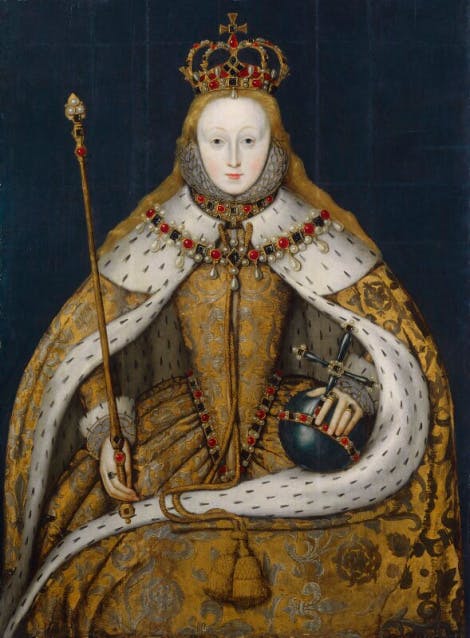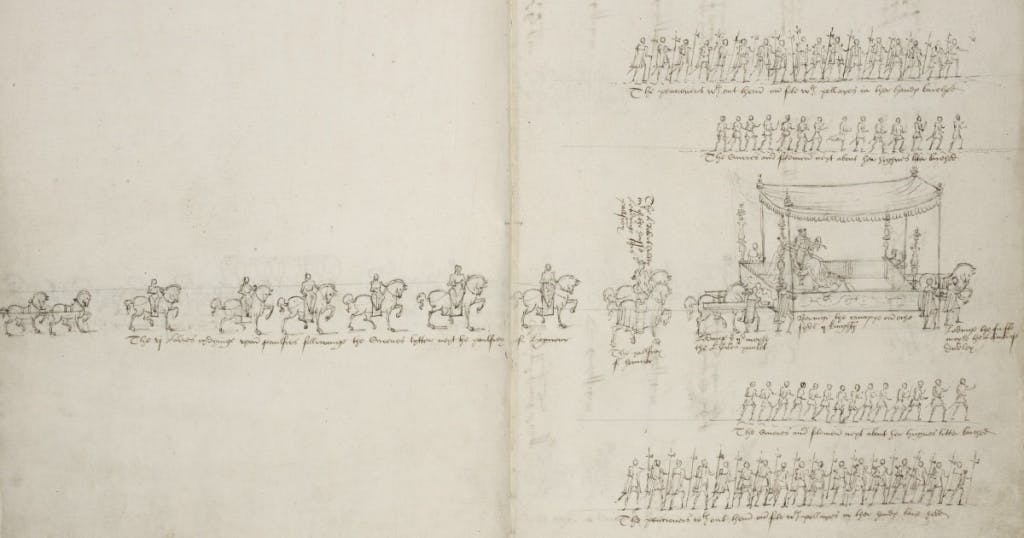Elizabeth I’s coronation procession from the Tower of London
Date: 17 November 2022
Author: Dr Charles Farris"The wonderfull spectacle"
Thursday 17 November marks the accession of Queen Elizabeth I in 1558. With many minds turning to the subject of coronations, curator Charles Farris recalls Elizabeth’s dramatic procession from the Tower of London to Westminster the day before her own.
Image: The Coronation Portrait’ of Elizabeth I, by an unknown artist, painted in about 1600, presumably a copy from a lost original portrait of 1559. © National Portrait Gallery, London

The Procession Departs
At 14.00 on Saturday 14 January 1559, Queen Elizabeth I “marched from the towre to passe through the citie of London towarde Westminster, richely furnished, & most honorably accompanied…”. The Queen’s coronation took place the next day in Westminster Abbey, the traditional setting for coronations since William the Conqueror’s in 1066.
While many historic coronation rituals and celebrations survive to this day, the procession from the Tower of London has not. These processions were amazing spectacles allowing the people of London to both show their support for the new monarch and hint at the qualities they expected in return.
Setting off from the Tower of London, Elizabeth followed in the footsteps of her mother, Queen Anne Boleyn, who had made the same journey on 31 May 1533. Indeed, Anne was pregnant with Elizabeth at the time. One wonders if Elizabeth thought such a day would ever come for her. A queen who would become famous for her sartorial splendour, was dressed in a recycled gold and silver robe which had belonged to her sister Mary. Although at least she had a new bodice made for it.
Elizabeth was accompanied by “gentilmen, Barons, & other the nobilitie of this realme, as also with a notable trayne of goodly and beawtifull ladies, richly appoynted.” The Queen wore her hair down, a golden circlet on her head, and sat upon a cloth of gold cushion on a litter. Above her head was a canopy supported by the four Barons of the Cinque Ports. This was travelling in serious style.
Marvellous Pageants
As the Queen made her way through the streets of London, she was met by a richly dressed child, accompanied by musicians, who welcomed her on the city’s behalf. Elizabeth then encountered a series of spectacular pageants. These were elaborate theatrical stages upon which were acted out little plays.
The first, at Gracechurch Street, was rather incredible. A huge stage spanned the street depicting the Queen’s lineage on three tiers. On the lowest, two actors played Henry VII and Elizabeth of York encircled by huge red and white roses. Above them an actor portraying Henry VIII was seated next to another as Anne Boleyn. At the top was portrayed Queen Elizabeth herself enthroned and wearing an imperial crown. The Queen had arrived, and her people were glad.
The next, at Cornhill, depicted the Queen upon a throne supported by seven actors playing virtues (Pure Religion, Love of Subjects, Wisdom and Justice). These were trampling upon eight more actors who played vices (Superstition, ignorance, Rebellion, Insolence, Folly, Vain Glory, Adulation, and Bribery etc.). The City was not being shy about promoting the sort of monarch they were hoping for. The next pageant, at Soper Lane, in a similar vein presented eight children playing the eight blessings of God.
At Little Conduit the pageant was a little more ambiguous. Two hills were depicted, one fertile and one desolate. Characters representing Time and Truth presented Elizabeth with a Bible inscribed Verbum Veritatis (The word of truth). Perhaps a rather opaque indication of the Protestant direction the City hoped the Queen would lead them in.
The final pageant was on Fleet Street just beyond the city walls. It showed the Queen in parliamentary robes depicted as Deborah, Judge of Israel. She was surrounded by representatives of the clergy, nobility, and common people. From here the Queen progressed to Westminster Hall passing two characters from British legend, the giants Corineus and Gogmagog. Perhaps they came as a little light relief after so much moral education.
Image: Mount Parnassus pageant design by Hans Holbein the Younger, from the collections of the Kupferstichkabinett, Staatliche Museen Zu Berlin. Licensed under CC BY-NC-SA 3.0.

Celebration and Symbolism
It’s hard for us to imagine the splendour, noise, and excitement of these early coronation processions. Trumpets and drums filled the air. The streets were hung with precious fabrics and fountains ran with wine. The fantastical pageants and their performers towered above all. At the heart of the proceedings was the monarch in almost unimaginable splendour. But it wasn’t just about showing off.
The whole procession and its pageants were drenched in symbolism. As Elizabeth was met with seemingly unanimous joy and good wishes, she surely pondered how deep their loyalty ran. As Elizabeth gazed at the miraculous pageants, she would also have interpreted their meaning too. The final depiction of the Queen in Parliamentary robes surrounded by her people was perhaps a reminder that her position was dependent on good governance and cooperation. Food for thought indeed as she took her first steps as Queen.
Charles Farris
Public Historian for the History of the Monarchy
HM Tower of London
Suggested Further Reading
Alice Hunt, The Drama of Coronation: Medieval Ceremony in Early Modern England (Cambridge, 2008)
More from our blog

Elizabeth I's Brush with Death at Hampton Court, 1562
06 September 2024
In 1562, Elizabeth I was taken suddenly and dangerously ill at Hampton Court Palace. Her courtiers were thrown into panic; if the young Queen died, it could spell the end of the Tudor dynasty.

Elizabeth I: History's Healthiest Monarch?
15 January 2024
Elizabeth I was top of the Tudor tree when it came to health and fitness. Always a resourceful woman, she chased away ‘melancholy’ with a whole host of entertaining pursuits.

The Tragic Story of Lady Katherine Grey
08 November 2022
Chief Curator Tracy Borman takes a look at the life of Katherine Grey, who like her sister, Lady Jane Grey, was imprisoned at the Tower of London.

